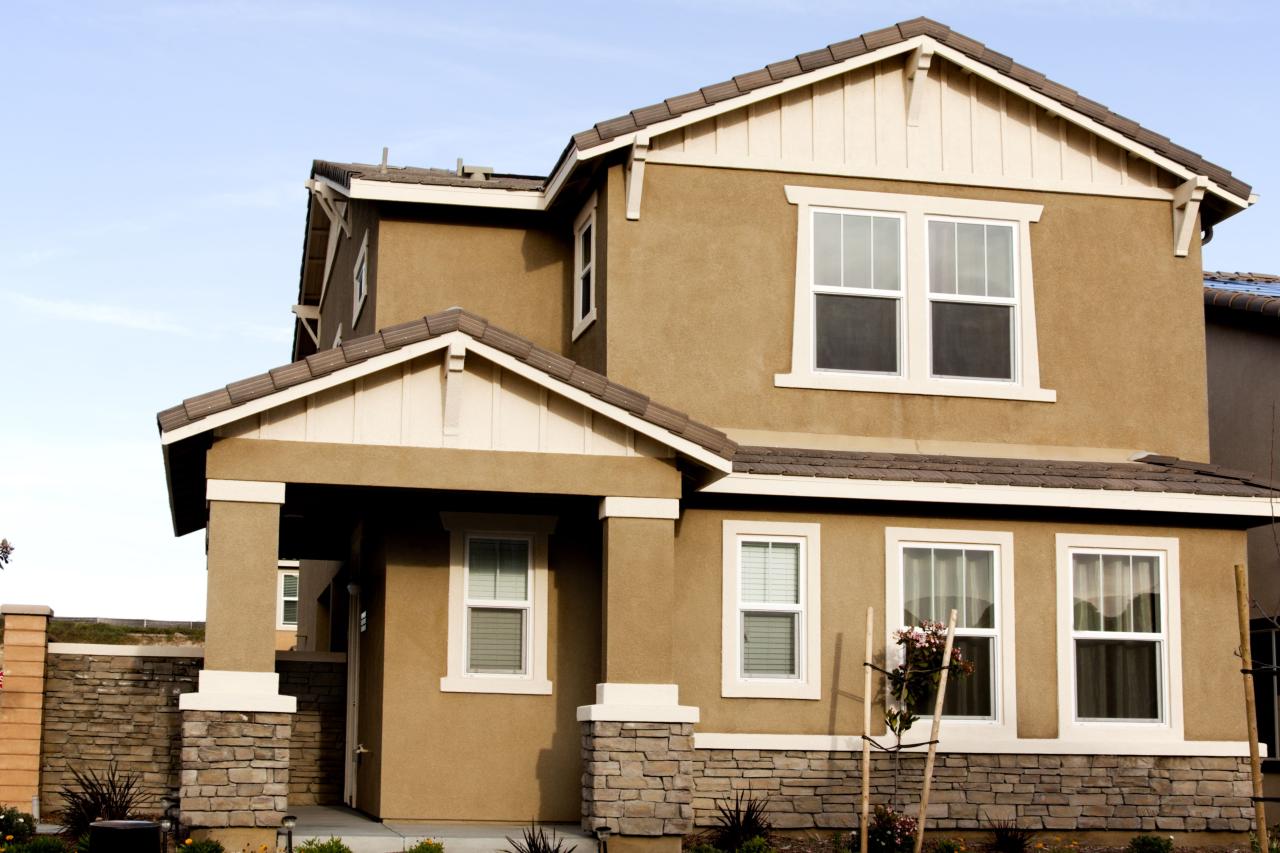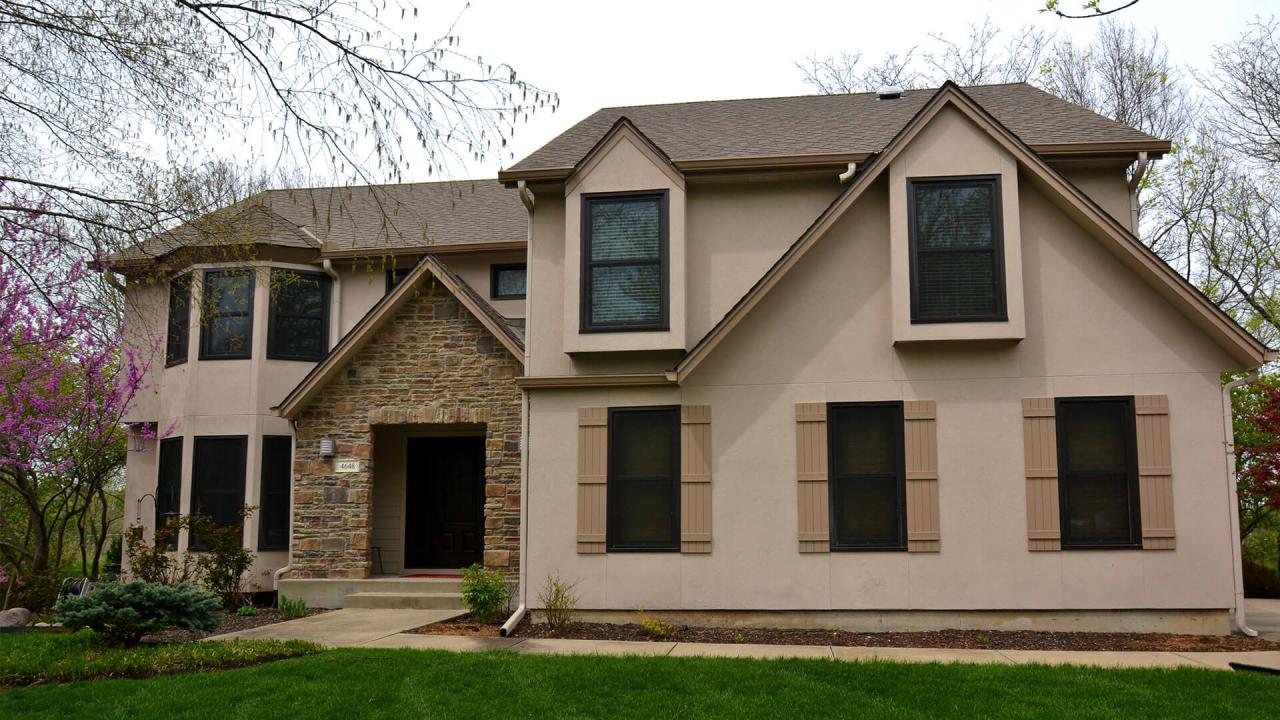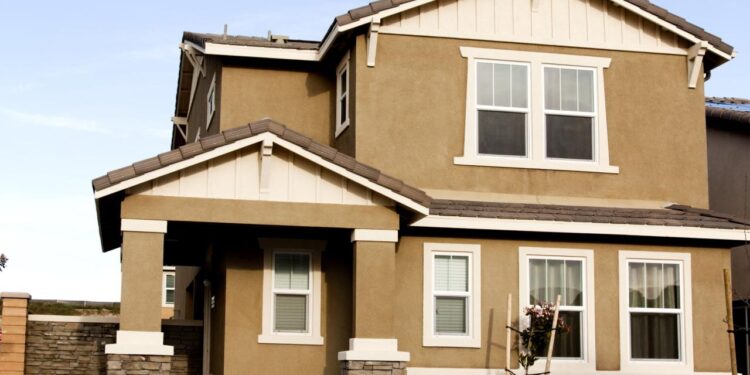Stucco siding houses have a unique charm that captivates homeowners and passersby alike. From its versatile design options to its durability, stucco siding offers a timeless appeal that enhances the overall aesthetic of any home. Let's delve into the world of stucco siding houses and uncover the secrets behind their popularity.
As we embark on this journey, we will explore the various aspects of stucco siding houses, from their installation and maintenance to their design and longevity. Join us as we unravel the beauty and benefits of stucco siding for modern homes.
Overview of Stucco Siding Houses
Stucco siding is a popular choice for house exteriors due to its durability and versatility. Made from a combination of cement, sand, and water, stucco is applied in multiple layers to create a seamless finish that can be textured or smooth.
Characteristics of Stucco as a Siding Material
Stucco is known for its durability and low maintenance requirements. It is resistant to fire, rot, and pests, making it a long-lasting option for homeowners. Additionally, stucco is available in a wide range of colors, allowing for customization to suit any architectural style.
Benefits of Using Stucco for House Exteriors
- Excellent durability and longevity
- Low maintenance requirements
- Fire, rot, and pest resistant
- Versatile design options with various textures and colors
Popular Stucco Siding Styles
- Spanish Colonial: Features a smooth stucco finish with decorative accents such as arched doorways and wrought iron details.
- Mediterranean: Incorporates textured stucco walls with earthy tones and terracotta roof tiles for a warm and inviting look.
- Modern: Showcases clean lines and minimalist design with a smooth stucco finish in neutral colors for a sleek appearance.
Installation of Stucco Siding
Installing stucco siding on a house is a meticulous process that requires careful preparation and attention to detail. Here is a step-by-step guide for preparing the surface and applying stucco, along with different application techniques:
Preparing the Surface for Stucco Application
- Clean the surface: Remove any dirt, debris, or old paint from the exterior walls to ensure a smooth base for the stucco.
- Repair any damaged areas: Fill in cracks, holes, or other imperfections in the wall with a suitable filler material to create a uniform surface.
- Apply a bonding agent: Before applying the stucco, prime the surface with a bonding agent to help the stucco adhere better to the wall.
- Install metal lath: Secure metal lath to the wall to provide a framework for the stucco to grip onto.
Application Techniques for Stucco Siding
- Traditional three-coat stucco: This method involves applying three layers of stucco – the scratch coat, brown coat, and finish coat – allowing each layer to dry before applying the next one.
- One-coat stucco: As the name suggests, this technique involves applying a single, thicker layer of stucco that combines the functions of the scratch, brown, and finish coats.
- Exterior Insulation and Finish System (EIFS): EIFS is a synthetic stucco system that includes insulation board and a base coat of adhesive and fiberglass mesh before applying the finish coat.
- Acrylic stucco: This type of stucco is made with acrylic polymers, which offer greater flexibility and durability compared to traditional stucco.
Maintenance and Care of Stucco Siding
Proper maintenance is essential to ensure the longevity and appearance of stucco siding. By following these maintenance tips, you can keep your stucco siding in top condition for years to come.
Common Maintenance Tasks for Stucco Siding:
- Regularly inspect the stucco for cracks, chips, or damage caused by impact or weather.
- Seal any cracks or gaps to prevent moisture from seeping into the stucco and causing further damage.
- Keep vegetation trimmed away from the stucco to prevent mold, mildew, or staining.
- Repaint or touch up the stucco as needed to maintain its appearance and protect it from the elements.
How to Clean and Upkeep Stucco Siding Properly:
When it comes to cleaning stucco siding, a gentle approach is best to avoid damaging the surface. Use a soft brush, mild detergent, and water to scrub away dirt and grime. Avoid using pressure washers, as they can cause water to seep behind the stucco and lead to moisture-related issues.
Regular cleaning can help prevent the buildup of dirt, mold, or stains on the stucco.
Frequency of Inspections and Repairs Needed:
- Inspect your stucco siding at least once a year to catch any issues early and prevent extensive damage.
- After severe weather events, conduct a thorough inspection to check for any new damage that may have occurred.
- Address any repairs promptly to prevent further deterioration of the stucco and avoid costly repairs in the future.
Durability and Longevity of Stucco Siding
Stucco siding is known for its exceptional durability and longevity, making it a popular choice for many homeowners looking for a long-term siding solution. Let's dive into the specifics of why stucco siding stands out in terms of durability.
Comparing Durability
Stucco siding is highly durable compared to other siding materials such as vinyl or wood. Stucco can withstand harsh weather conditions, including extreme heat, cold, rain, and wind, without deteriorating quickly. This durability factor makes stucco a cost-effective option in the long run.
Factors Affecting Longevity
Several factors can impact the longevity of stucco siding. One crucial factor is the quality of the installation. Proper installation by experienced professionals ensures that the stucco is applied correctly, preventing issues like cracks or water damage. Additionally, the maintenance and upkeep of the stucco siding play a significant role in its longevity.
Regular cleaning, inspections, and repairs can extend the lifespan of stucco siding on a house.
Extending Lifespan
To extend the lifespan of stucco siding on a house, it is essential to perform routine maintenance tasks. This includes inspecting the siding for any cracks, chips, or signs of moisture damage. Promptly addressing any issues can prevent them from escalating and causing more significant damage to the stucco.
Additionally, cleaning the stucco siding regularly with a gentle detergent and water can help maintain its appearance and structural integrity over time.
Design and Aesthetics of Stucco Siding Houses

Stucco siding houses offer a versatile canvas for various design options that can significantly enhance the overall aesthetics of a home. The texture and color choices can play a crucial role in improving curb appeal and creating a visually appealing exterior.
Exploring Design Options for Stucco Siding Exteriors
- Smooth Finish: A sleek and modern look can be achieved with a smooth stucco finish, providing a clean and elegant appearance.
- Textured Finish: Adding texture to stucco siding can create depth and visual interest, giving the house a more unique and rustic charm.
- Architectural Details: Incorporating architectural elements like trim, moldings, or decorative accents can further enhance the design of stucco siding houses.
Enhancing Curb Appeal with Stucco Siding
- Color Selection: Choosing the right color for stucco siding is essential in improving curb appeal. Lighter shades can make a house appear larger and more inviting, while darker colors can add drama and sophistication.
- Complementary Features: Pairing stucco siding with other materials like stone, wood, or brick can create a visually appealing contrast and enhance the overall curb appeal of the house.
Tips for Choosing the Right Color and Texture
- Consider the Surroundings: Take into account the landscape, neighboring houses, and architectural style of the neighborhood when selecting colors and textures for stucco siding.
- Sample Testing: Before committing to a color or texture, it's advisable to test samples on a small area of the house to see how they look in different lighting conditions.
- Consultation: Seeking advice from design professionals or contractors can help in choosing the right color and texture that best suits the overall design and aesthetic goals of the house.
Final Thoughts

In conclusion, stucco siding houses stand as a testament to both style and substance in the realm of home exteriors. With their unmatched durability, customizable designs, and easy maintenance, stucco siding continues to reign supreme as a top choice for homeowners seeking a blend of elegance and functionality.
Embrace the allure of stucco siding houses and elevate the look of your home with this timeless siding option.
Essential FAQs
How long does stucco siding typically last?
Stucco siding can last anywhere from 50 to 80 years with proper maintenance and care.
Is stucco siding expensive to install?
While initial installation costs may be higher than some other siding materials, stucco siding's longevity and low maintenance requirements make it a cost-effective choice in the long run.
Can stucco siding be painted?
Yes, stucco siding can be painted to change its color or refresh its appearance. It is important to use breathable paint specifically designed for stucco surfaces.
How often should stucco siding be inspected?
It is recommended to have stucco siding inspected annually to catch any potential issues early and prevent costly repairs.


